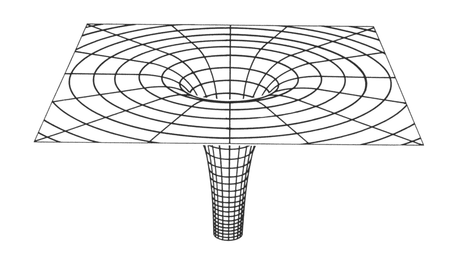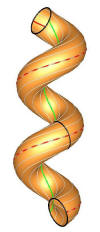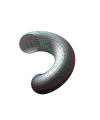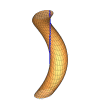Course Catalog Description:
|
MAT 5600 - Differential
Geometry
Description:
Geometry of curves and surfaces, curvature, first
and second fundamental forms, minimal surfaces, use
of MAPLE [forget minimal surfaces!]
Prerequisites:
MAT 2500 [MAT2705 too!]
Corequisites:
Credit Hours:
3.0
Last Offered:
Spring 2008 by Robert Jantzen, Spring 2001, Fall 1996 by Klaus Volpert |
|
|
Spring 2013 MWF 9:30 - 10:20.
Updated for 2013 with extra material incorporated
involving symmetry groups, the
hyperbolic geometry of special relativity and simple black
hole examples [see below]. The course will start with a simple exercise from
multivariable calculus that enables us to compute the so called geodetic
precession effect measured by the
GP-B satellite
experiment. We will review some of multivariable calculus that we need
so we can all start on the same page. Physics majors who want to understand the language of modern
theoretical physics and math majors who like multivariable calculus and
differential equations and linear algebra applied to some whimsical topics
in geometry are the target audience for this course. Maple will be a welcome
tool in working problems in this course, and in generating pretty graphics.
For a sample see pasta design (Pasta by Design,
CBS Sunday
morning spot) or
what, relativistic pasta?
Are you kidding, bob? No. Let's have fun for a change. Isn't that why we
were attracted to mathematics in the first place?
More stuff:
What is this stuff?
Differential geometry is the mathematics used to describe curved spaces,
building on the foundations of multivariable calculus and linear algebra.
For the very first time, this course will be an elementary introduction to differential geometry
that will not only to deal with the geometry of curves and surfaces but will
have an eye towards simple 2-dimensional applications to the flat geometry of
special relativity and to the curved geometry associated with a spherical black
hole. Problem sets will be assigned throughout the semester to make lectures,
notes and readings more concrete through calculation, with some guided assistance from Maple
when helpful.
I am thinking that this course will start off by revisiting how one treats the geometry of curves and
surfaces in Multivariable/Vector Calculus, and by slightly adjusting the
familiar details (we'll remember them!), one can extrapolate easily to handle
both curved spaces and see how the flat hyperbola geometry associated with the hyperbolic functions
usually ignored in calculus describes very nicely the heart of special relativity
(time dilation, length contraction, Lorentz transformations). Similarly building
on the use of polar, cylindrical and spherical coordinates in flat space, one
can easily handle curved spaces with the same tools, enabling one to understand
the usual suggestive surface representations of the deformation of the Euclidean
plane by the presence of a black hole [see the illustration above above]. You don't have to be an Einstein to
comprehend these elementary ideas! We will try to have some fun.
Watch a woman astrophysicist
talk about how and why she
uses this mathematics.
Newton and Liebnitz were the leading thinkers behind calculus back in the
17th
century (the 1600s!). Although the curvature of a curve was contemplated long
before calculus entered the picture, and afterwards as well, it took some time before calculus was used to explore the
complete geometry of
curves by a couple of
French
mathematicians Frenet and Serret around 1850 and it was even later that this
was presented in the vector calculus style of modern textbooks. This geometry is
important in elementary physics to describe centripetal accelerations and
centrifugal forces that we all (well most of us) have direct experience with
from driving cars around curves in the road or riding roller coasters in an
amusement park.
However, once curves were investigated, it was
natural to move on next to surfaces. In the mid 1800s
Gauss, one of the most prolific mathematicians of all time,
pioneered this field, but it
was his student
Riemann who got serious about curved spaces of any dimension. Unfortunately, he did not live
long enough to fully develop the tools of Riemannian geometry, which was left to others, most
notably some Italian mathematicians
Ricci and
Levi-Civita who were the principle thinkers behind
tensor calculus at
the turn of the 19th (to 20th) century, ready just in time for Einstein to apply
their machinery to his curved spacetime theory of gravitation called general
relativity. Einstein, however, as a physicist who did not like to write lots of
equations, was not big on abstract mathematics and had to be introduced to this
stuff by a friend who was a mathematician (Grossmann)
in the early 1900s. After some rumination time, general relativity was born in
1916. This pushed curved geometry into the public imagination and physicists
continued using this kind of geometry to unify their force fields for the rest
of the 20th century. String theory is the latest part of the program to
geometrize the forces of nature.
Interestingly enough GPS (gravitational positioning system) is an acronym
which has quickly become a part of our daily life, most commonly in car
navigational systems, but more and more available in our cell phones and other
technology devices. GPS
would not
work without special and general relativistic effects that differential
geometry provides the calculational tools for evaluating.
However, you don't have to be interested in describing the fundamental forces
of nature to use differential geometry—it has lots of more mundane applications. For
example a flower that is shaped like a trumpet horn initially growing outward
from the base is symmetric about an axis of symmetry, but as it bends outward
while growing,
eventually its curvature will cause it to no longer be rotationally symmetric
but develop ruffles [see the article
Crumpling, buckling, and cracking: elasticity of thin sheets, Physics Today,
February 2009 (comment),
followup: Custom shapes from swell gels
].
Differential geometry and physics?
Better yet:
Differential geometry, fiber bundles and physical theories by
Isadore M. Singer, Phys. Today 35, 3, 41 (1982)
or Reflections on Relativity (on-line
book) by Kevin Brown.
cute stuff




